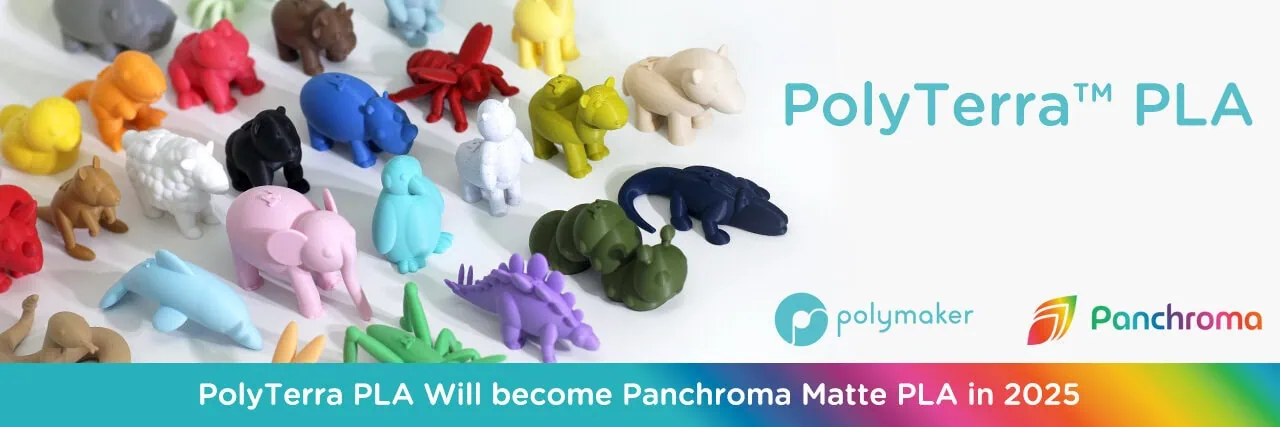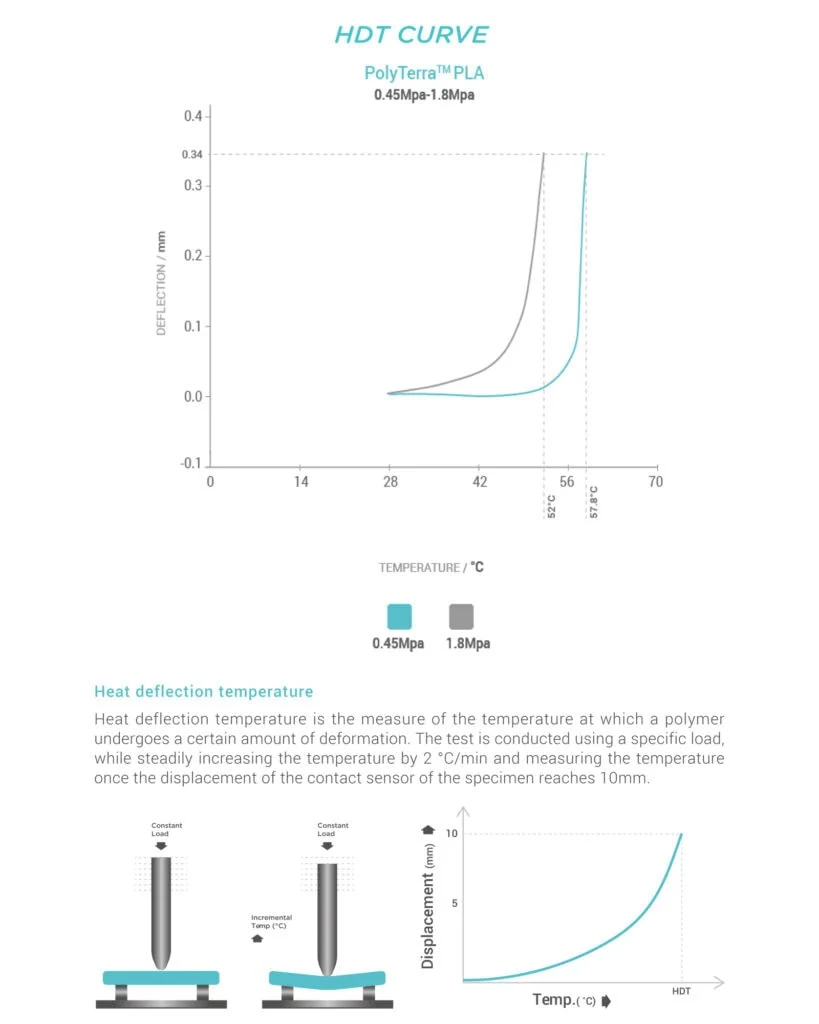Panchroma™ Matte PLA (old name PolyTerra™ PLA)
Features
- Frosted surface and fun colors – Print parts with a beautiful frosted surface and unleash your imagination with the fun and vibrant color range of Panchroma™ PLA. Panchroma™ PLA renders patterns with excellent surface quality and features great iridescence and remodeling ability.
- Optimized for Supports – Panchroma™ PLA is designed with excellent support removal properties, allowing users to more easily tear supports or rafts from the surface of their prints.
- Easy sanding – Panchroma™ PLA is softer and easier to sand than conventional PLA filaments and can be easily painted.
- High-speed printing capability – Polymaker have developed the base formulation of Panchroma™ PLA with ideal flow properties to provide a filament that is capable of high-speed printing (with appropriate hardware only).
- Bioplastic Matte PLA Formula – Panchroma™ PLA is based on a newly developed material from Polymaker called FBC (Fully Bio Compound). It is a compound of high quality Ingeo PLA supplemented with naturally occurring elements. The result is a PLA filament with less plastic content that feels softer and more elastic/less brittle on the reel. Polymakers FBC formula contains less PLA plastic to degrade, which improves the rate of degradation under specific industrial conditions. Like other PLAs, the degradation rate is still very slow at ambient temperatures.
- Ductility (X-Y ) – Panchroma™ PLA is softer than conventional PLA, providing better ductility along the horizontal X-Y axis compared to standard PLA formulations. While a test strip of standard PLA will break in bending, Panchroma™ PLA will tend to gradually bend and break along the horizontal axis.
- Improved ductility – Panchroma™ PLA provides improved ductility that is less brittle (Charpy Impact) in the X-Y axis compared to standard PLA formulations.
- Compatibility / Jam-Free™ – Panchroma™ PLA is compatible with a wide range of 3D printers and is manufactured using Polymakers Jam-Free™ technology, which results in excellent print quality with zero risk of nozzle clogging caused by thermal creep [1]. Panchroma™ PLA works well on many printing surfaces with a thin layer of adhesive applied, no bed heating is required but can be used at 40 – 50°C for better results (60°C maximum).
- Uncompromising Quality – Panchroma™ PLA filament is manufactured with the highest quality ingredients, including Ingeo® from Natureworks; a high quality PLA material made from rapidly renewable plant resources in the USA. Combining Polymakers’ innovative R&D technologies, blending and extrusion systems with Natureworks’ Ingeo® resins yields a reliable 3D printing filament that prints beautiful and accurate models.
[1] Thermal creep is the process of uneven distribution of heat across a hot end, a common example being in all metal hot end structures. Once the heat creeps toward the cold end, the PLA filament softens prematurely at the cold end and expands, resulting in jamming. Polymakers’ Jam-Free™ technology increases the heat resistance of the filament itself (not the printed part) to 100˚C, which prevents the filament from softening prematurely at the cold end and can still melt quickly once it enters the heating zone.
Print settings
Nozzle temperature 190°C – 230°C
Building plate temperature 25°C – 60°C*
*You may find that lower bed temperatures (e.g. 45°C) work better with Panchroma™ PLA compared to higher temperatures.
Build Surface Material – Compatible with most common build surfaces.
Build Surface Treatment- Apply a thin layer of PVA or PVP adhesive.
Cooling Fan – On
Print Speed- 30 mm/s – 70 mm/s
Retraction- Ideal retraction settings vary by printer. If you find that the flap settings are causing gaps in your workpiece, the following settings may help.
Direct Drive: Flap spacing of 0.5 – 1 mm with a flap speed of 20 mm/s
Bowden: Flap spacing of 2 – 3 mm with a flap speed of 20 – 40 mm/s
Recommended support material- Single extrusion:
Self Maintenance
Double extrusion:
PolyDissolve™ S1 (dissolves in tap water)
PolySupport™ (easily disassembled support material)
Based on a 0.4 mm nozzle. Printing conditions can vary between printers and nozzle diameters.
To produce flatter and more accurately sized parts, Panchroma™ PLA may work best on your printer at lower bed temperatures (i.e. 45 – 50°C ) compared to higher bed temperatures (i.e. 55 – 60°C+ ) .
Specification
Net weight- 1 kg
Material type- Matte PLA (fully biocomposite)
Density- 1,31 g/cm3
Diameter tolerance 99% probability +/- 0.03 mm
98% probability +/- 0.02 mm
Technical data
All test specimens were printed under the following conditions: Nozzle temperature = 200˚C, build plate temperature = 60˚C, leachate = 100%, cooling fan = on
All specimens were conditioned at room temperature for 24 hours prior to testing.
THERMAL PROPERTIES
Value Test method
Glass transition60,6°C DSC, 10°C/min
Thermal deviation temperature
0,45 MPa – 57,8°C
1,8 MPa – 52°C
HDT curve
ISO 75 0,45 MPa
Softening point Vikat62,7°C ISO 306, GB/T 1633
MECHANICAL PROPERTIES
Value Test method
Young’s modulus
(X-Y)1882 ± 141 MPa ISO 527, GB/T 1040
Tensile strength
(X-Y)20.9 ± 2.0 MPa ISO 527, GB/T 1040
Flexural strength
(X-Y)39.6 ± 1.1 MPa ISO 178, GB/T 9341
Impact strength Sharpey
(X-Y)5.7 ± 0.4 kJ/m2 ISO 179, GB/T 9343
We have complete MDS and technical data sheets for Panchroma™ PLA and all other Polymaker products. Contact us to inquire!
The typical values presented in the Polymaker data sheet are for reference and comparison only. Due to the nature of 3D printing, they should not be used for design specification or quality control purposes.
STORAGE AND DRYING
Like other PLA filaments, Panchroma™ PLA is susceptible to absorbing moisture from the air, which can subsequently affect the print quality and mechanical properties of the final prints.
Although filaments can be dried, drying will accelerate the aging process of the plastic, making it more brittle over time. Preventing moisture from being absorbed by the filament in the first place is the best solution to keep your filament at its maximum potential. For long-term storage, we highly recommend storing it in a sealed container with a desiccant dryer that reduces the relative humidity to 10-20% RH.
If you hear popping sounds and notice that the surface quality of your print is uneven or the color is not consistent, this is a likely indicator that the filament has absorbed too much moisture. Panchroma™ PLA spools can be dried with a Polymaker filament dryer or whichever brand is convenient for you, using power level 1. Alternatively, if you have a convection oven that is accurate at low temperatures, users can dry the filament in a pre-heated convection oven at 55˚C for up to 6 hours. Results may vary depending on the accuracy of your oven, so please use caution.
FREQUENTLY ASKED QUESTIONS
Q: Does Jam-Free™ technology prevent all thread jams?
A: Jam-Free™ technology is designed to prevent jamming caused by thermal creep. There are many reasons why a material can clog, such as printing at the wrong extruder temperature or incorrect nozzle height; Polymaker’s Jam-Free™ technology will not prevent clogging in these cases.
Q: Is Panchroma™️ PLA safe for food?
A: Panchroma™️ Polymaker’s PLA complies with RoHS Directives 2011/65/EU and (EU) 2015/863 and the REACH regulation, meaning it contains no toxic or harmful listed substances. However, due to the nature of FDM 3D printing, printed Panchroma™️ PLA parts may have micro cracks and holes that are invisible to the naked eye, even though the prints appear smooth. Bacteria tend to grow in these micro cracks and pinholes and therefore we do not recommend using 3D printed parts in applications that are in contact with food.
Q: How long does it take to degrade Panchroma™️ PLA?
A: Panchroma™️ PLA degrades under the specific conditions of industrial composting, namely at a certain temperature and humidity with the presence of micro-organisms. The rate of degradation depends on the size and thickness of the printed part. Polymaker conducted a compostability test, certified to ISO 14855-1, with a third-party laboratory which showed that Panchroma™️ PLA degraded faster than comparable PLA material. The test was performed by placing small pellets of Panchroma™️ PLA in 2-4 month old plant compost (incorporating a wide variety of microorganisms) and heating the system to 60˚C. During this process, the Panchroma™️ PLA will begin to break down into carbon dioxide, water, and mineral salts, and the aforementioned elements are monitored to calculate the mass of Panchroma™️ PLA degraded. After 45 days, 93.6% of the Panchroma™️ PLA is degraded, and Polymakers estimates that complete degradation of Panchroma™️ PLA can take less than 100 days. Polymaker conducted the exact same test with their PolyLite™️ PLA, which is pure ordinary PLA, and after 45 days 79.9% of it degraded. Which means that Panchroma™️ PLA degrades up to 15% faster than regular PLA.
Q: What auxiliary materials can I use with this product?
A: Panchroma™ PLA is designed with excellent support removal properties, allowing users to more easily tear supports or rafts printed in Panchroma™ PLA. PolyDissolve™ S1 or Polymaker’s PolySupport™ are the recommended support filaments for Panchroma™ PLA if your machine can print in multiple materials. If your 3D printer is not equipped to handle multiple materials, self-support can be used.
Q: Do I need to rewind this thread if I want to use it with another spool?
A: We strongly advise you not to manipulate the product by rewinding. All Polymaker filaments are wound with tension but without strain. Rewinding completely rearranges the curvature of the coil and this tension over time can cause most plastics to catastrophically break. If for some reason your printer is blocked from mounting smaller than standard size spools, there may be safe print adapters or external mounting solutions available.
Don’t know where to start? Or which thread would be right for your application? Contact us today!
Threads:
Diameter 1,75 mm
Spool weight 1 kg

















There are no reviews yet.